Remaking the Universities in Bangladesh: The Case of Trash Journals
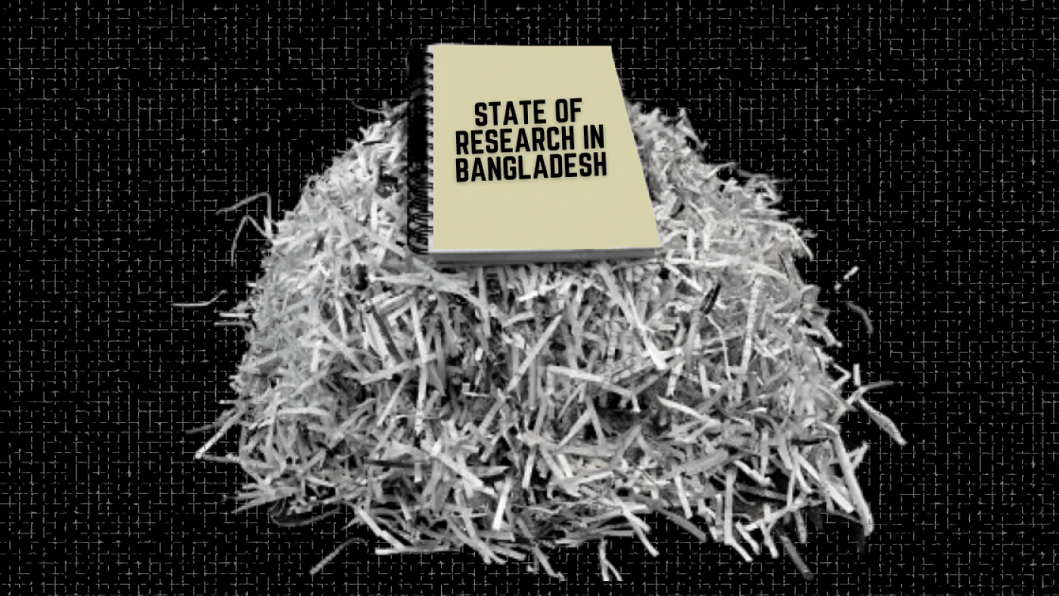
Dhaka University, the country's first university – "the Oxford of the East" – reached two concurrent milestones this year. It celebrated its 100th anniversary with pomp and festivity. On the other hand, it failed miserably to prevent its downward slide that began since the promulgation of the ordinance of 1973. In the latest Quacquarelli Symonds (QS) World University Rankings, while nine universities from India and three from Pakistan were recognised as Top 500 global institutions, not even a single university from Bangladesh could make it to the Top 800 list. Dhaka University, the first higher education institution (HEI) to be ranked by the QS from Bangladesh, placed 365th in 2005. It ranked between 550th and 600th in 2010, between 601st and 700th in 2012, between 701st and 800th in 2014, and this year, along with the Bangladesh University of Engineering and Technology (Buet), it ranked between 801st and 1000th. This year, the QS analysed a total of 1,500 HEIs for its global ranking.
Ranking data pertaining to Dhaka University, in particular, was documented first in "Dhaka University: Can It Turn Around?" (BDNews24.com, December 24, 2011). It was followed by the book University of Dhaka: Making, Unmaking, and Remaking (Prothoma Prokashan, July 2016), which hoped "if a generation of humans got involved in making the university and sadly another generation in unmaking it, then surely there is hope that, yet another generation of humans will engage themselves in remaking the university." Unfortunately, those who are driving the HEIs in Bangladesh are often in denial, and are either unwilling or unequipped to interpret data and take necessary corrective actions.
It is far too easy to explain away the crisis in Bangladeshi HEIs saying there's a lack of money to fund research, books, laboratories and salary. This article seeks to pinpoint the near-term issues and identify recommendations that universities in Bangladesh can and will need to address themselves, as well as the long-term issues that will require powers beyond the universities – the government, the University Grants Commission (UGC), and political parties – to come to their rescue. It's imperative that we understand the data that is indicative of the unmaking of DU and its root causes, if there is any hope for "remaking the university."
Professor Emeritus Dr Serajul Islam Choudhury once made the following sobering confessions: "We never thought of promotions. Now-a-days, as soon as they get appointed, lecturers focus on promotion, and they are not even afraid to commit plagiarism to that end... We established autonomy of the universities after much struggle. The university ordinance is an outcome of our movement. But these things have no value now as the vice-chancellors cannot make decisions autonomously, which affects the recruitment of teachers in the university." He concluded that the university had become "an educated people's slum" (Dhaka Tribune, October 4, 2017).
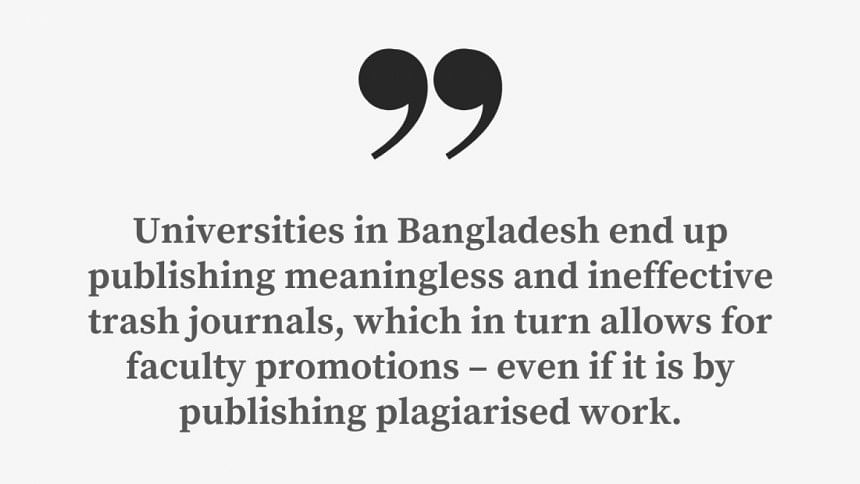
The standing of research universities is determined typically by how they are ranked by the prowess of their faculty, as measured by both the quality and quantity of new knowledge generated by them and the success of their graduates. In this race for the top, world-class universities are more like Sisyphus having to roll an immense boulder up a steep climb, only for it to roll down when they get near the top. As can be imagined, the best and the most successful research universities thus try their best so that they can at least hold onto (if not further improve) their latest rank. On the other hand, the HEIs that are either failing or sinking, such as those in Bangladesh, tend to seek comfort by either critiquing the ranking algorithm or threatening to create a new ranking of their own. In the case of Dhaka University, its leaders typically fall back on DU's political and cultural role and its glorious political past, including the Language Movement and the country's liberation struggle, but hardly ever its academic and research success. My humble suggestion: Stop sitting on this laurel that is of little solace or value to this global race.
Dr Kamal Hossain, who authored "Revisiting the Dhaka University Order, 1973" (The Daily Star, April 29, 2008) aptly concluded that its mandated elections "not only became a magnificent, but a terrible and destructive obsession pursued within the university, exorcising the pursuit of excellence and upholding of academic values and standards, and afflicting an increasing number of teachers with a kind of appetite for power politics, and pursuit of narrow self-interest, with no holds barred and no values respected, and working only along the narrowest of party lines… The ordinary students were reduced to hostages, and they lived in fear."
Recognising that the algorithm used in ranking universities has its own nuances, one can easily track and conclude if a particular HEI is either ascending or descending. The QS ranking of HEIs takes into consideration six metrics with relative weights distributed as follows: Academic Reputation (40 percent), Employer Reputation (10 percent), Faculty-Student Ratio (20 percent), Citations per Faculty (20 percent), International Faculty Ratio (five percent), and International Student Ratio (five percent).
"A fish rots from the head down," so goes the proverb. DU and other Bangladeshi HEIs have been no different. There have been 16 vice-chancellors (VCs) at DU since January 21, 1972. While VCs are expected to have varying leadership qualifications, as far as academic and/or research strength are concerned, their collective record has been rather sobering. The citation record for 10 of these 16 VCs over their total lifetime is zero, according to Google's Advanced Scholar. For all VCs together, as of writing this piece, their research work was cited 1,662 times – an average of 103.9 citations for each, a rather pathetic number.
One of the outcomes of the 1973 Dhaka University ordinance has been an explosion of university-based, mostly low-quality journals that serve as vehicles to justify faculty promotions. Publications in these journals, a large fraction of which are typically plagiarised, serve to convey in effect falsity that the faculty members publishing in these venues are engaged in research. In 2011, the six faculties of Dhaka University were producing six half-yearly English journals and one 10-monthly Bangla journal. These six journals were all offshoots of the Dhaka University Studies that began in the 1950s, while the Journal of Statistical Research started in the 1970s. By 2018, according to the DU website, the number of such DU journals grew to 13 and by 2022 has grown to 17. Most of these journals don't have enough issues a year, nor do they have focus, depth, or quality in any one field of research interest and, as such, nothing therein stands a chance of being cited by anyone except through self-citation. Five of these Dhaka University journals haven't published a single issue since 2010; one never had an issue. Most importantly, none of these 17 ever had an impact factor. The situation isn't any different in other Bangladeshi HEIs – public or private. Both Rajshahi University and Chittagong University are right behind DU and are incurring similar reputational consequences.
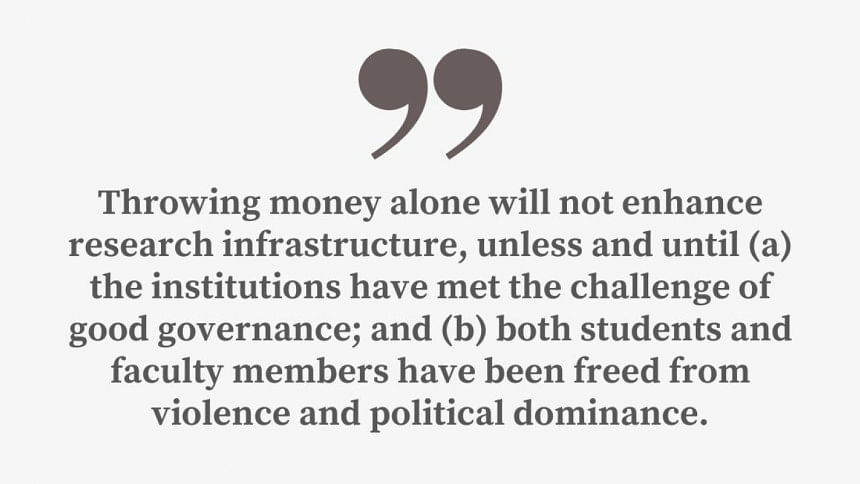
The Bangladesh Journals Online (BanglaJOL), launched in 2007, boasted the existence of 73 Bangladeshi journals in 2011. In the next 11 years, the number has more than doubled, now standing at 157. Thirty-one of these are published by public HEIs, nine by private HEIs, and 25 by medical HEIs, while 92 have been produced by professional organisations. A perusal of the BanglaJOL website reveals that 19 of these 157 are not functional anymore. The management of BanglaJOL transferred to the Bangladesh Academy of Sciences (BAS) in 2014. The recently published "BAS Activity Report 2019-2021" documents how many individuals viewed and/or downloaded these BanglaJOL articles, and from which countries. The report is strangely silent about how many of these 157 titles are contributing to the research enterprise.
The latest SCImago Journal Rank (SJR) provides an assessment of all citable journals from 239 countries. Only 12 from Bangladesh qualified to be among those 34,100 globally ranked journals. Each journal is ranked in terms of their SJR – i.e. the number of citations of its published articles over the previous three years. In comparison, the impact factor refers to the number of citations in the last two years. The H-index of a journal is another significant measure that indicates that the H number of its articles have received at least H citations.
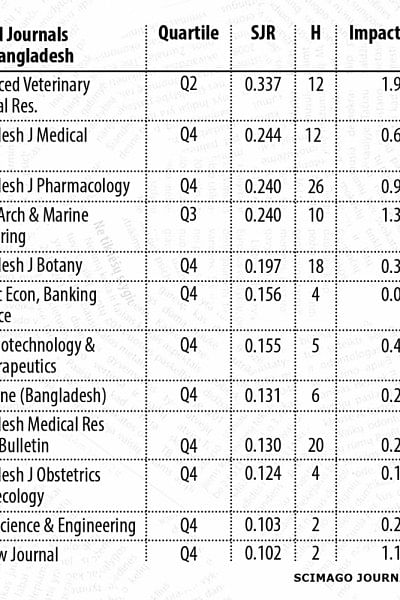
Of the 12 from Bangladesh listed, the Journal of Advanced Veterinary and Animal Research (with an impact factor of 1.910) falls within the second quartile, the Journal of Naval Architecture and Marine Engineering (with an impact factor of 1.300) falls within the third quartile, and the remaining 10 falls within the fourth quartile. It can be concluded with absolute confidence that 145 of 157 – i.e. 92.3 percent – BanglaJOL journals are trash journals that don't contribute to much of anything as far as scientific impact is concerned. Sadly, that long list of ineffective BanglaJOL journals includes the Journal of Bangladesh Academy of Sciences, now in its 46th year of publication, as well as all journals that are produced by Dhaka University, for example.
Why aren't the Bangladeshi trash journals contributing to new knowledge? Almost all aspects of Bangladeshi public universities, including the hiring of faculty members, are aimed at guaranteeing political control. As such, the universities end up publishing meaningless and ineffective trash journals, which in turn allows for faculty promotions – even if it is by publishing plagiarised work. Too many university leaders themselves have benefited from this corruption and, as such, are reluctant to stop these, lest their own crimes become public, according to the April 15, 2015 report of the International Network for the Availability of Scientific Publications.
Based on data, trend, and recent emergence of several influencers, Bangladeshi higher education institutions (HEIs) must take proactive steps to stop their downward slide. While many find it convenient to ask for only funding and fellowships in support of the researchers, it alone will not resolve the current crisis. At a minimum, Bangladesh will need to put a stop to all but the top 20 or so journals. This step alone will save scarce resources, which can be redirected by the HEIs to produce citable research. Most importantly, this act will force the current faculty members to do meaningful research, which can be published only in journals that matter – drastically reducing plagiarism and increasing the overall citation statistics for the Bangladeshi HEIs.
Spending money alone will not enhance research infrastructure, unless and until (a) the institutions have met the challenge of good governance; and (b) both students and faculty members have been freed from violence and political dominance. Infusion of research money will be inconsequential until there are objective measurements to judge submitted research proposals and track progress of research, and such investment can guarantee high-impact publications. Research budget numbers for the Bangladeshi HEIs are quite revealing. According to Prothom Alo (July 26, 2020), Dhaka University, for example, allocated over Tk 40.8 crore in the 2019-20 fiscal year, yet it could spend only Tk 28.7 crore.
In 2020, according to the UGC, out of 46 public universities, 38 universities spent Tk 72.91 crore in research, while out of 107 private universities, 77 universities spent Tk 111.73 crore on research. It is illustrative to note two private universities from Bangladesh (Brac University and North South University), listed previously only under QS Asia University Ranking category, got elevated for the first time in the global category; they were ranked between 1000th and 1200th. In the category of QS Asian Universities, there are seven other ranked HEIs (one public and six private) from Bangladesh. Each of these HEIs stand a good chance to join the category of global HEIs in a few years if they can be particularly selective about their research efforts and programmes.
The UGC will need to be bold enough and effective in remaking both public and private universities. In the short term, to be on one's own remaking trajectory, Bangladeshi HEIs will need to:
● Cease producing trash journals,
● Incorporate aspects of ethics in general and academic honesty into research, curriculum, teaching, and training,
● Confront those who commit academic misconduct, irrespective of one's political affiliations,
● Encourage and reward faculty members and students to do meaningful research, so their works appear in high-impact global journals, and
● Subject all appointment, promotion, and retention of faculty only on the basis of a quantifiable record of scholarly research and teaching.
Dr Mohammad A Karim is professor of electrical and computer engineering at the University of Massachusetts Dartmouth in Massachusetts, US.

 For all latest news, follow The Daily Star's Google News channel.
For all latest news, follow The Daily Star's Google News channel. 





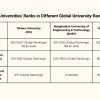

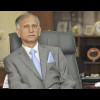
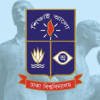


Comments